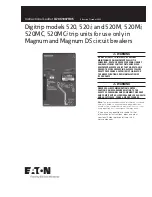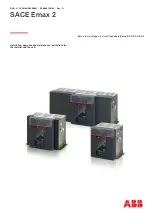
Breaker Racked In - Lever And Armature
Linkage Pin Not Engaged
Breaker Being
Racked Out -
Lever Activates Armature
Linkage
FIG.
17
-
CLOSING SPRING
INTERLOCK
6.4
DISCONNECT POSITION INTERLOCK
The function of the Disconnect Position Interlock is to
block the RACKING SCREW cover open when the racking
mechanism is in the DISCONNECTED position. When the
cover is held open, the TRIP button is depressed. The
mechanism is held trip-free and there is no contact arm
movement when the closing spring is discharged by the
Closing Spring interlock.
The operation of this interlock is shown in Fig. 18. A
crank, which is attached to the racking mechanism shaft, is
connected to the blocking plate through a link. As the shaft
turns, the blocking plate rotates; holding the cover open in
the DISCONNECTED position, but allowing it to close in
the TEST and CONNECTED positions.
FIG. 18 -
DISCONNECT POSITION INTERLOCK
6.5
PADLOCKS
Provisions are made in all breakers to use padlocks to
prevent the breaker from being closed. For non Type B or D
breakers the padlock shackle goes through the TRIP but
ton hole and out the slot in the side of the escutcheon. For
Type B or D breakers the padlock shackle goes through the
TRIP button hole and out the RACKING SCREW cover
hole in the deep escutcheon. In either case, the shackle
holds the TRIP button in keeping the mechanism trip-free.
17
www
. ElectricalPartManuals
. com












































